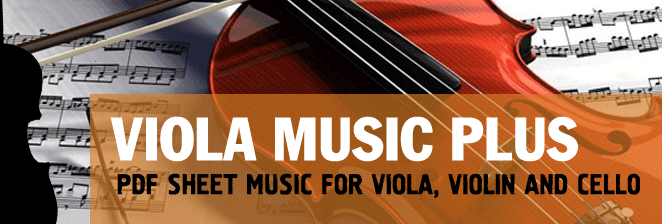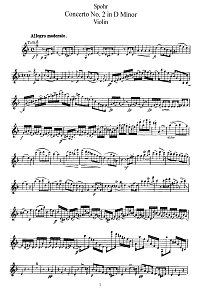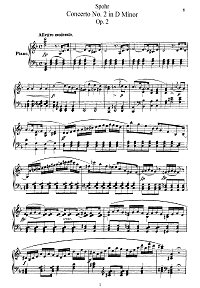|
|
 |
|
| |
| |
Spohr - Violin concerto N2 d-moll
Spohr - Violin concerto N2 d-moll. You can download the PDF sheet music Spohr - Violin concerto N2 d-moll on this page. Spohr's Violin Concerto No. 2 in D minor op. 2, a highly individual amalgamation of French and German stylistic elements, was the compositional manifestation of this attainment. The Allegro moderato begins with a forceful tutti anticipating the suspense of the subsequent musical process. The march rhythm and the dotted, fully syncopated melodic treatment of the main theme point to its derivation from the style of the French revolutionary operas of Luigi Cherubini, a composer admired by Spohr and Beethoven alike. The forces inherent in the theme, here still under control, issue forth in a violent eruption in the elaboration.
To download PDF, click the "Download PDF" button below the appropriate sheet music image.
To view the first page of Spohr - Violin concerto N2 d-moll click the music sheet image.
|
| PDF format sheet music |
|
|
|
Instrument part: 13 pages. 769 K
|
Piano part: 23 pages. 1504 K
|
 |
 |
|
|
| Download PDF (14.99
€) |
Download PDF (14.99
€) |
|
|
After the abrupt halt of the main theme and a suspenseful general pause, the subsidiary theme begins in F major and without the benefit of harmonic and motivic mediation. The noble lyrical line of the subsidiary theme and its broad intervals forms an effective contrast to the serious main theme and its narrow intervals. This surprising change in general character and key had no precedents in the concertos of Viotti, Kreutzer, and Rode; it was a feature of Spohr's personal style and his early feeling for romantic color effects. The musical uniqueness of the young Spohr comes into full, brilliant focus in the subsidiary theme along with his tendency toward grandiloquence and toward the maintenance of seriousness even in lyrical expression. The motivic design of the main theme leads back to the initial key of D minor in the course of the orchestral introduction. Here Spohr's predilection for chromatic usage is already in evidence.
The soloist does not bear the burden of a conservative double exposition with the repetition of the previous material. Rather the solo exposition begins with a new melody of its own. The melody is of greater cantability than the main theme and is clearly separated from the subsequent passage work, something entirely in keeping with Kreutzer's style. The subsidiary theme displays its full luxuriant warmth in the solo part. In the tutti inserts following on the passages, Spohr modulates to B minor, a key only remotely related to the principal key, with motifs from the main theme. Surprisingly enough, here the soloist returns to the gloomy march theme from the orchestral introduction. The integration of such thematic elements into the musical process was foreign to the composers of the French concerto. The new entry of the subsidiary theme marks the beginning of the recapitulation, following the model of the first movement from Rode's Concerto No. 7 in A minor of 1 803. The rest of the movement is cast in a radiant D major. The Allegro moderato, as the whole of the work, is remarkable for its brief, concise formulation of musical statements.
The Adagio forms the spiritual center of the concerto as a whole. It is also the first example of a sort of musical cryptography often encountered in Spohr's oeuvre. In 1926 the music scholar Hans Joachim Moser noticed two citations from Bach's St. Matthew Passion in the Adagio and termed them »peculiar« because he
was not aware of the background behind them. The musical mentor of Spohr's youth, the Brunswick Court Music Director Johann Gottfried Schwanberger, died on 5 April 1 804, Spohr's twentieth birthday. Schwanberger had received his training as an opera composer in Italy and with Hasse in Dresden. Since Schwanberger's father had studied with Johann Sebastian Bach and he himself was a personal friend of Bach's son Carl Philipp Emanuel, he was thoroughly acquainted with the polyphonic traditions of the Baroque and was in the position to impart to the young Spohr the knowledge of a then by and large forgotten music culture, a knowledge which formed the foundation of Spohr's later involvement in the revival of early music, above all that of Johann Sebastian Bach, in the 1 820s and 1 830s. Schwanberger's death seems to have occasioned the composition of this demanding Adagio, a movement of complete symmetry in formal design.
The soloist, almost always playing two parts, is entrusted with the first section. The beginning of the three-part middle section casts a dark shadow over the quiet, peaceful atmosphere (A major). A minore frame in A minor has an always ascending, imitative scale motif in dotted sixteenths over the continuous pounding of eight. The unrelenting forward progress and sorrowful character of the suspensions reflect the expression of funeral and passion music and are linked to arias No. 35 »Geduld, Geduld, wenn mich falsche Zungen stechen« and No. 57 »Komm, süßes Kreuz« from Bach's St. Matthew Passion. This minore frame encloses the formal and spiritual focus, the soloist's ornamented, »sung« melody in a radiant C major. At the conclusion of this section Spohr has the violin cite the concluding choral number from the St. Matthew Passion, »Ruhe sanfte, sanfte ruh'!«
It is here that the purpose of what Moser termed Spohr's »strange penning« of citations from baroque passion music in an instrumental concerto is revealed. The young composer was carrying out a task he had assigned himself with artistic seriousness and intellectual-spiritual responsibility. Such perfect integration of foreign musical phenomena in one's own style for the expression of a personal eulogy honoring someone esteemed by the composer would not be encountered again until Alban Berg's Violin Concerto a century later. Spohr's Adagio concludes with an abbreviated repetition of the first section and with the second Bach citation, this time without the following laments in minor.
Power and feathery elegance characterize the last movement, Alia polacca. When compared to this fiery rondo, the concluding movements of French concertos seem mechanical and wooden. The original main theme is almost entirely reserved for the solo part, here clearly the leading part and and a part of great virtuosity, and occurs only once in the orchestra. The orchestra's role is limited to accompaniment and to the presentation of the vehement contrast-ritornello. The tempestuous, stormy ascent and descent of tirades and syncopated and dotted notes in the ritornello draw on the expressive realm of the first movement. The orchestra concludes this work of perfectly integrated form and content with the same ritornello.
The instrumentation of the work also merits special mention. Following the model of Mozart's piano concertos, Spohr deliberately omits the oboes from the woodwind sound, refrains from the use of trumpets in the brass sections (but not from the use of timpani), and adds a trombone to the two horns. His close study of Luigi Cherubini's opera scores left clear traces here. Thus the sound nowhere tends toward harshness or to loud noisiness, does not lose any of its clarity (despite the vehement tutti), and is of splendid, full color. |
|
|
|
|
| |
|
|
| |
|
|
|
|